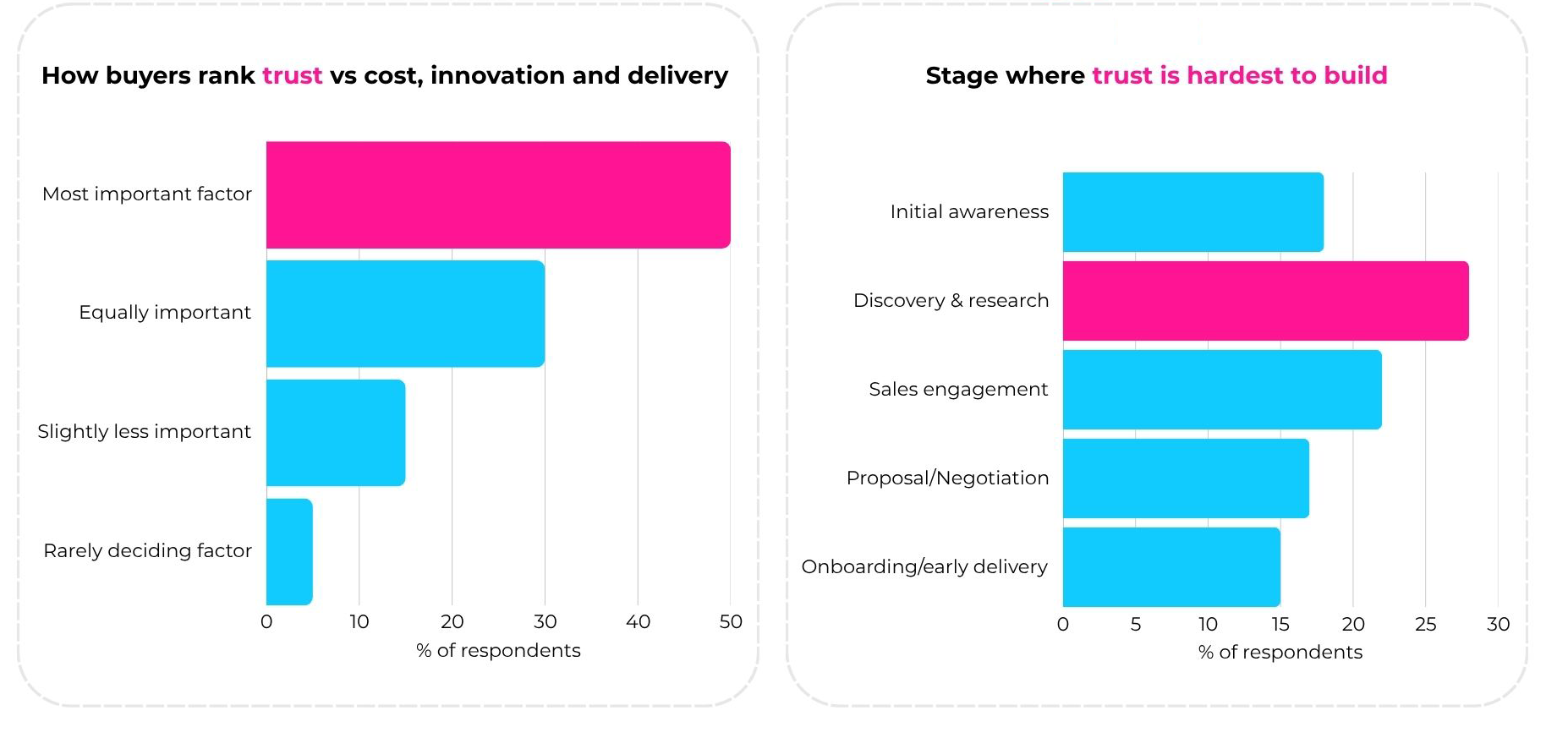PRmoment is relaunching its editorial coverage of PR and communications research. As part of this refresh EC-PR’s managing director, Lorraine Emmett will analyse new research shaping the communications and technology landscape. It will cut through the noise to uncover what the data really means for brands, marketers and reputation builders.
This first edition explores The Trust Advantage, EC-PR’s study revealing why trust now outranks cost, innovation and delivery in B2B tech buying and how credibility has become the hardest currency in sales.
Key findings
PRmoment speaks with Lorraine Emmett, managing director at EC-PR.
What prompted EC-PR to explore trust as a research theme?
Lorraine Emmett: We saw a gap. Major studies from Gartner, Edelman-LinkedIn and Coleman Parkes had already shown that B2B buying behaviour has shifted. Longer cycles, more stakeholders and a growing preference for independent decision-making have changed how buyers build confidence. Yet none explained how trust is actually built or lost during that journey, especially for mid-sized tech firms competing with global giants. We wanted to shift the conversation from theory to action, identifying where trust breaks down and what practical steps marketers can take to regain it.
What headline finding stood out most?
LE: Trust now outranks everything. Half of senior tech buyers told us it is the most decisive factor in vendor selection, ahead of cost, innovation and delivery.
Even more revealing, seven in ten have walked away from a deal that looked right on paper simply because something “didn’t feel right.” Confidence has become the deciding factor in complex B2B sales.
When does trust matter most?
LE: Earlier than most people think. Twenty-eight per cent said they find it hardest to trust a vendor during the research stage, before they have even spoken to sales. This is where first impressions are formed. If your content is thin, pricing is opaque, or leadership is invisible, buyers hesitate. Once doubt sets in, it is difficult to reverse.
What signals actually build credibility?
LE: Buyers were clear: transparent pricing (49 per cent), relevant case studies (48 per cent), compliance credentials (45 per cent) and visible leadership (52 per cent) are the top trust signals.
It is not about glossy marketing. It is about proof over promise, showing what you have delivered, how you deliver it and who stands behind it.
How do market conditions affect this?
LE: When pressure rises, trust becomes non-negotiable. Nearly half of buyers said it is much more important during a downturn. As one CTO put it, “A wrong vendor choice sets you back six to eight months. That risk makes trust absolutely central when money is tight.” So, while competitors discount, credible brands defend their margins because they feel safer buying from them.
What role does AI play in building or breaking trust?
LE: AI divides opinion. Used transparently, it enhances credibility for almost half of buyers. Used carelessly, it destroys it. Authenticity is the dividing line. Buyers told us they can spot AI-generated content instantly. They want to see humans using AI, not AI speaking for the brand. Authenticity still has to sound like a person who knows what they are talking about.
You also talk about hidden buyers. Who are they?
LE: They are the stakeholders who influence the deal without ever joining a call: finance, procurement, compliance and operations.
Our data shows discovery and research are the hardest stages to establish trust, precisely because these hidden buyers are forming opinions in the background. If your communications do not address their priorities, the deal will stall before it even begins.
Finally, what can CMOs do to help themselves?
LE: Treat trust as a strategy, not a sentiment. You cannot claim it, you have to earn and prove it, visibly and consistently. Start by auditing your first impression. Before anyone talks to sales, buyers are assessing your credibility based on your content, leaders, and digital footprint. That is where most trust gaps open.
Then make credibility deliberate:
Show, don’t tell. Publish case studies with measurable outcomes, not adjectives. Explain how you price and what changes it.
Put leaders in the spotlight. Buyers trust people, not logos. Named experts should be visible and accountable on the issues that matter.
Engineer trust for every stakeholder. Finance wants assurance, compliance wants evidence, and operations want proof of performance. Speak to each directly.
Keep it human, even when you use AI. Automation can scale communication, but never at the expense of the authentic human voice that signals integrity and intent.
The businesses that will do well during the next decade are not those shouting the loudest; they are the ones proving the most. Build trust early, show your workings and let your credibility do the selling.
“Trust is the hardest currency in B2B sales. When you close the trust gap, you both protect and power your pipeline.”
Lorraine Emmett, managing director, EC-PR
PR Masterclass: The Intersection of PR and GEO
Join PRmoment for a Masterclass featuring 10 of the industry’s foremost experts. You will walk away with a clear, actionable strategy for adapting your content to an AI-first search environment.
Taking place on Wednesday 25th February in London, both virtual and in person tickets are available.
Early bird ticket sale ends Friday 9 January.
PR MasterclassIf you enjoyed this article, sign up for free to our twice weekly editorial alert.
We have six email alerts in total - covering ESG, internal comms, PR jobs and events. Enter your email address below to find out more:










